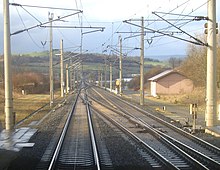Transfer point

A transfer point (abbreviation Üst ) is an operating point on the free line of a railway . It is also a block post . The term transfer point is used in Germany and Austria; in German-speaking Switzerland, changing lanes is used. Within train stations in Austria one speaks of a parallel switch .
Definition in Germany
From the definition valid in Germany , according to which a railway line can only be single-track or double-track , it follows that trains at a transfer point can pass from one track of a single or double-track section to another track of a double-track section of the same line . Depending on the security technology that has been set up, this other track can be used as an exception or regularly ( track changing operation ) against the usual direction of travel.
The operational term of the transfer point as a subset of the branch point only emerged in Germany with the construction of the high-speed lines . There were already operating points at which trains could only transfer to another track on the same route, but they were included in the designation junction. Junction points and train stations can continue to be used to cross between tracks.
The transfer point for Germany is described in Section 4 (6) of the Railway Construction and Operating Regulations (EBO).
Definition in Switzerland
In Switzerland the term is not commonly used. The term lane change point (French poste à diagonales d'échange, Italian posto di cambio di binario ) is used here in the driving regulations . Simplifying and in the oral language is mostly of lane change (French diagonale d'échange, Italian cambio di binario ).
construction
A transfer point requires at least one switch . Single or double track changes are common on double-track lines, with each track change consisting of two switches and an intermediate piece. The double track change is a so-called soft trapezoidal applied as the four points, and the tracks of the enclosed path, the shape of a trapezium yield. Very often - but not necessarily - the points and block signals of a transfer point are remotely set or controlled by a central interlocking.
See also
literature
- Swiss Driving Service Regulations (FDV) A2016 Federal Office of Transport (FOT), July 1, 2016 (PDF; 3 MB)
Individual evidence
- ↑ For example R300.11 section 2.1.2

